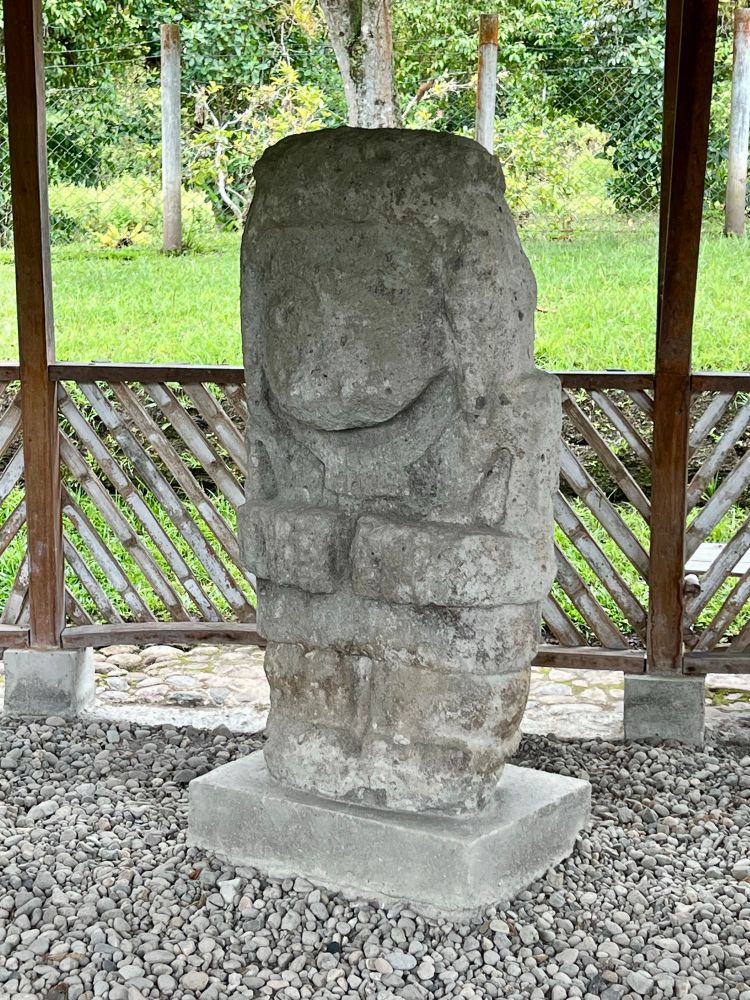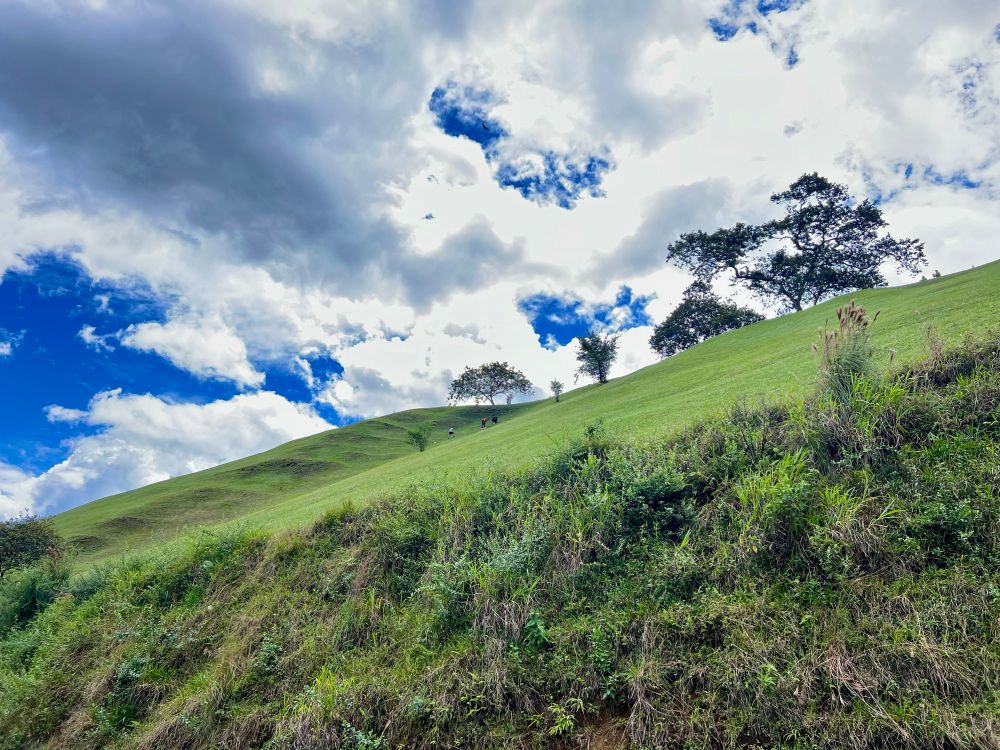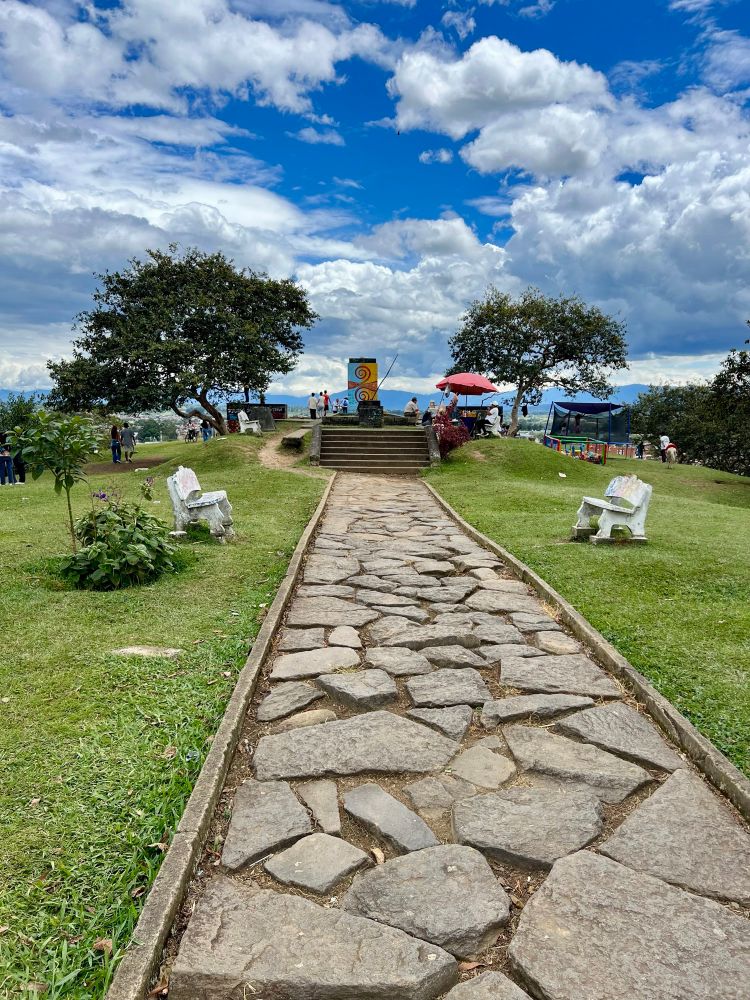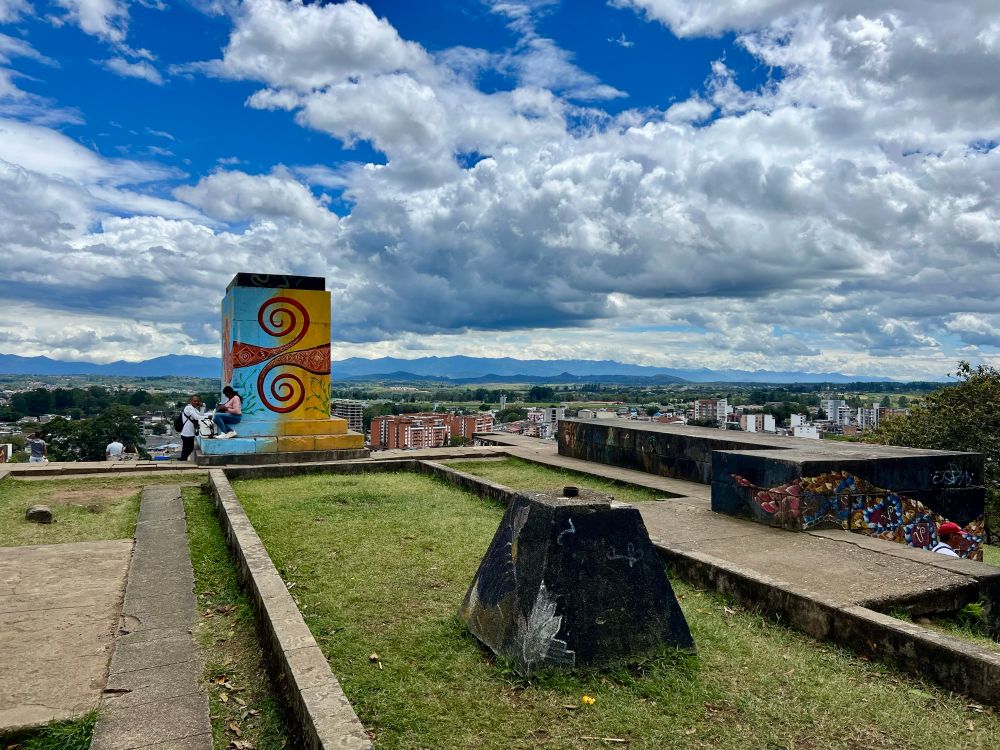Antiokhos in the West
@antiokhos.bsky.social
History, archaeology, beer. Delighting in Amazonic excess. Greece, Rome, China, Latin America, Britannic tribes. Hunting down Saxon churches. Twitter: @AntiokhosE
The site, Colombia’s answer to Egypt’s Luxor or China’s Tang tombs, is almost criminally undervisited - we had it almost to ourselves.
That said, the road conditions offer a good explanation - our journey back taking almost ten hours as we were trapped by successive landslides 5/5
That said, the road conditions offer a good explanation - our journey back taking almost ten hours as we were trapped by successive landslides 5/5



July 22, 2025 at 12:37 PM
The site, Colombia’s answer to Egypt’s Luxor or China’s Tang tombs, is almost criminally undervisited - we had it almost to ourselves.
That said, the road conditions offer a good explanation - our journey back taking almost ten hours as we were trapped by successive landslides 5/5
That said, the road conditions offer a good explanation - our journey back taking almost ten hours as we were trapped by successive landslides 5/5
Radiocarbon dating suggests the tombs could be up to 1500 years old, but even this is controversial due to later contamination and potential reuse of the tombs.
Their black and white decoration combines both abstract patterns and images of people - deities? ancestors? - across the pillars /4
Their black and white decoration combines both abstract patterns and images of people - deities? ancestors? - across the pillars /4



July 22, 2025 at 12:33 PM
Radiocarbon dating suggests the tombs could be up to 1500 years old, but even this is controversial due to later contamination and potential reuse of the tombs.
Their black and white decoration combines both abstract patterns and images of people - deities? ancestors? - across the pillars /4
Their black and white decoration combines both abstract patterns and images of people - deities? ancestors? - across the pillars /4
There are virtually no records of the people who built the tombs, with theories suggesting they moved away, were wiped out by disease, or buried under volcanic eruptions before the Spanish arrived.
The only clues we have are their silent ceremonial statues sprinkled around the hills /3
The only clues we have are their silent ceremonial statues sprinkled around the hills /3



July 22, 2025 at 12:28 PM
There are virtually no records of the people who built the tombs, with theories suggesting they moved away, were wiped out by disease, or buried under volcanic eruptions before the Spanish arrived.
The only clues we have are their silent ceremonial statues sprinkled around the hills /3
The only clues we have are their silent ceremonial statues sprinkled around the hills /3
The hypogea are burial chambers (or, technical, reinhumation chambers - used for reburying remains), up to 7m deep and richly decorated. Their structure seems to mimic buildings - presumably the communal houses of the people who built them - but that’s about all we know /2



July 22, 2025 at 12:26 PM
The hypogea are burial chambers (or, technical, reinhumation chambers - used for reburying remains), up to 7m deep and richly decorated. Their structure seems to mimic buildings - presumably the communal houses of the people who built them - but that’s about all we know /2
Finishing off rather more prosaically, Popayán’s most recognisable landmark is the clock tower on its central square, a 17th century Jesuit construction.
A little plaque marks an excellent piece of trivia - the clock itself was made in Croydon, England, and shipped over in 1737 6/6
A little plaque marks an excellent piece of trivia - the clock itself was made in Croydon, England, and shipped over in 1737 6/6

July 19, 2025 at 3:12 PM
Finishing off rather more prosaically, Popayán’s most recognisable landmark is the clock tower on its central square, a 17th century Jesuit construction.
A little plaque marks an excellent piece of trivia - the clock itself was made in Croydon, England, and shipped over in 1737 6/6
A little plaque marks an excellent piece of trivia - the clock itself was made in Croydon, England, and shipped over in 1737 6/6
The Morro del Tulcán is an ancient earthen pyramid - likely a ceremonial mound of the Pubenza culture, earth-worked atop a natural hill to perhaps carry out astronomical observations.
Excavations have shown at least the top 30% is artificial - a massive monument looming over the Spanish city /5
Excavations have shown at least the top 30% is artificial - a massive monument looming over the Spanish city /5



July 19, 2025 at 3:07 PM
The Morro del Tulcán is an ancient earthen pyramid - likely a ceremonial mound of the Pubenza culture, earth-worked atop a natural hill to perhaps carry out astronomical observations.
Excavations have shown at least the top 30% is artificial - a massive monument looming over the Spanish city /5
Excavations have shown at least the top 30% is artificial - a massive monument looming over the Spanish city /5
Before the Spanish, Popayán was home to its namesake Pubenza people - whose traces are lost under the colonial city.
That is except for one extraordinary site to its north east, recently reappraised after local indigenous campaigns to remove a monument to the conquistador Belalcázar… /4
That is except for one extraordinary site to its north east, recently reappraised after local indigenous campaigns to remove a monument to the conquistador Belalcázar… /4



July 19, 2025 at 3:04 PM
Before the Spanish, Popayán was home to its namesake Pubenza people - whose traces are lost under the colonial city.
That is except for one extraordinary site to its north east, recently reappraised after local indigenous campaigns to remove a monument to the conquistador Belalcázar… /4
That is except for one extraordinary site to its north east, recently reappraised after local indigenous campaigns to remove a monument to the conquistador Belalcázar… /4
Popayán’s mansions and churches weren’t built on modest means. Strategically placed on the Andean passes it became a centre for mining wealth, cattle ranching, and trade - gold, silver, and slaves - turning it into one of colonial Colombia’s elite power bases /3



July 19, 2025 at 2:59 PM
Popayán’s mansions and churches weren’t built on modest means. Strategically placed on the Andean passes it became a centre for mining wealth, cattle ranching, and trade - gold, silver, and slaves - turning it into one of colonial Colombia’s elite power bases /3
The city was founded in 1537 by Sebastián de Belalcázar, making it one of Colombia’s oldest cities, managing trade between Quito to the south and Cartagena to the north - soon attracting Dominicans, Franciscans, and Jesuits as it grew over coming centuries /2



July 19, 2025 at 2:56 PM
The city was founded in 1537 by Sebastián de Belalcázar, making it one of Colombia’s oldest cities, managing trade between Quito to the south and Cartagena to the north - soon attracting Dominicans, Franciscans, and Jesuits as it grew over coming centuries /2
A dark side, the inquisition, was established as one of three tribunals in the Spanish Americas in Cartagena in 1610.
It targeted Protestants, crypto-Jews, foreigners, and African and indigenous paganism, using interrogation and torture in its holy mission /5
It targeted Protestants, crypto-Jews, foreigners, and African and indigenous paganism, using interrogation and torture in its holy mission /5


July 16, 2025 at 3:54 PM
A dark side, the inquisition, was established as one of three tribunals in the Spanish Americas in Cartagena in 1610.
It targeted Protestants, crypto-Jews, foreigners, and African and indigenous paganism, using interrogation and torture in its holy mission /5
It targeted Protestants, crypto-Jews, foreigners, and African and indigenous paganism, using interrogation and torture in its holy mission /5
Perhaps most important is the 17th century Jesuit Convento de San Pedro Claver - named after the eponymous priest who, arriving in Cartagena in 1610, start a forty year career ministering to the colony’s slaves, eventually dying in the convent’s still preserved infirmary /4



July 16, 2025 at 3:48 PM
Perhaps most important is the 17th century Jesuit Convento de San Pedro Claver - named after the eponymous priest who, arriving in Cartagena in 1610, start a forty year career ministering to the colony’s slaves, eventually dying in the convent’s still preserved infirmary /4
The mid-16th century Iglesia de Santo Domingo is the city’s oldest, with a beautiful lofty interior and massive stone buttresses - as well as a wonky campanile, perhaps due do changes in construction or shifting soil in the early city /3



July 16, 2025 at 3:45 PM
The mid-16th century Iglesia de Santo Domingo is the city’s oldest, with a beautiful lofty interior and massive stone buttresses - as well as a wonky campanile, perhaps due do changes in construction or shifting soil in the early city /3
Begun in 1577, the Catedral de Santa Catalina de Alejandría managed to survive sacks of the city - including Francis Drake knocking in its roof and one of its half finished stone piers - before it was eventually finished almost 40 years later, its over-engineered robustness keeping it standing /2



July 16, 2025 at 3:42 PM
Begun in 1577, the Catedral de Santa Catalina de Alejandría managed to survive sacks of the city - including Francis Drake knocking in its roof and one of its half finished stone piers - before it was eventually finished almost 40 years later, its over-engineered robustness keeping it standing /2
Today the fort is largely intact, including a vast warren of tunnels underneath the ramparts and through the hill they clad - contributing in no small part to Cartagena’s UNESCO World Heritage status 5/5



July 15, 2025 at 2:06 AM
Today the fort is largely intact, including a vast warren of tunnels underneath the ramparts and through the hill they clad - contributing in no small part to Cartagena’s UNESCO World Heritage status 5/5
The second expansion was triggered by its greatest challenge, when in 1741 Britain sent an attack force of 27,000 men and 186 ships under Admiral Vernon. Cartagena’s defenders - under Blas de Lezo - held firm and turned the tide in one of the greatest sieges of the colonial era /4

July 15, 2025 at 2:04 AM
The second expansion was triggered by its greatest challenge, when in 1741 Britain sent an attack force of 27,000 men and 186 ships under Admiral Vernon. Cartagena’s defenders - under Blas de Lezo - held firm and turned the tide in one of the greatest sieges of the colonial era /4
The crown jewel, however, is the enormous Castillo de San Felipe de Barajas. Built on San Lázaro hill to defend Cartagena’s landward side, the small fort was greatly expanded in 1657 and 1762 to become an interlocking sequence of ramparts and artillery platforms /3



July 15, 2025 at 1:59 AM
The crown jewel, however, is the enormous Castillo de San Felipe de Barajas. Built on San Lázaro hill to defend Cartagena’s landward side, the small fort was greatly expanded in 1657 and 1762 to become an interlocking sequence of ramparts and artillery platforms /3
Growing rich through its trade in gold, silver, and enslaved Africans, Cartagena became a tasty target and was sacked by Francis Drake in 1586 - leading the Spanish to begin a decades long programme of building, resulting in two circuits of almost 11km of walls around the islands of the city /2



July 14, 2025 at 10:32 PM
Growing rich through its trade in gold, silver, and enslaved Africans, Cartagena became a tasty target and was sacked by Francis Drake in 1586 - leading the Spanish to begin a decades long programme of building, resulting in two circuits of almost 11km of walls around the islands of the city /2
Mompós played an important role in Colombian independence: according to Simon Bolivia, ‘if Caracas gave me life, Mompos gave me glory’.
Its mansions housed a merchant class keen on liberation; and by the river a collection of warehouses were converted into an ad hoc fort during the struggles 5/5
Its mansions housed a merchant class keen on liberation; and by the river a collection of warehouses were converted into an ad hoc fort during the struggles 5/5



July 13, 2025 at 3:23 PM
Mompós played an important role in Colombian independence: according to Simon Bolivia, ‘if Caracas gave me life, Mompos gave me glory’.
Its mansions housed a merchant class keen on liberation; and by the river a collection of warehouses were converted into an ad hoc fort during the struggles 5/5
Its mansions housed a merchant class keen on liberation; and by the river a collection of warehouses were converted into an ad hoc fort during the struggles 5/5
The cathedral of the Immaculate Conception (mid-16th century) features a pretty coffered nave ceiling above a series of arcades; while the 17th century basilica and convent of San Agustín is filled with gold work beneath its rich wooden beams /4



July 13, 2025 at 3:16 PM
The cathedral of the Immaculate Conception (mid-16th century) features a pretty coffered nave ceiling above a series of arcades; while the 17th century basilica and convent of San Agustín is filled with gold work beneath its rich wooden beams /4
Mompós is particularly well known for its collection of stylistically unique churches, dating to the 16th and 17th centuries and dotted along the main waterfront axis of the town.
We were struggling a bit with the stifling heat, and inside the closed air was even more oppressive… /3
We were struggling a bit with the stifling heat, and inside the closed air was even more oppressive… /3



July 13, 2025 at 2:58 PM
Mompós is particularly well known for its collection of stylistically unique churches, dating to the 16th and 17th centuries and dotted along the main waterfront axis of the town.
We were struggling a bit with the stifling heat, and inside the closed air was even more oppressive… /3
We were struggling a bit with the stifling heat, and inside the closed air was even more oppressive… /3

